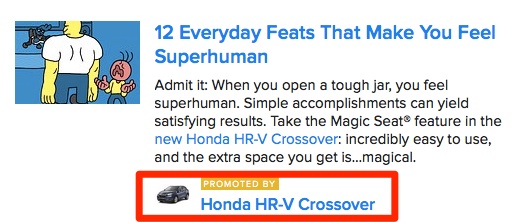Native advertising and sponsored content are confusing terms and often used incorrectly. Today, we try to make sense of both advertising mediums, include examples, and the controversy around them.
What is native advertising?
Native advertising is advertising that is native to the platform that you’re advertising on.
Think of sponsored tweets on Twitter or Facebook’s sponsored posts. These are ad buys that only Twitter and Facebook can sell as they are native to their platforms.
Native ad buys are unique to the platform you’re buying on. They are supposed to be more promotional, but because they are within the confines of a specific platform, they seamlessly integrate within the stream of information.
Native advertising’s growing popularity
Brands and advertisers favor native advertising because the ads create high engagement (clicks, likes, comments, etc.). For publishers, native advertising creates new revenue opportunities. Ad Age portends spending on native ads increasing 34% to $4.3 billion in 2015. What’s more, nearly two-thirds of advertisers intend to increase their native ad spending in 2015.
Examples of native advertising
Twitter has sponsored ads within their stream—virtually indistinguishable from other tweets.

Here, the New York Times embedded a paid post within other news stories.

Facebook has a bunch of different native advertising options. A “Sponsored Post” is an ad type that allows a business to advertise their Facebook posts regardless of whether the person has had any interaction or affiliation with the brand.
What is sponsored content?
Sponsored content is content typically created by the publisher and “sponsored by” or “brought to you by” the advertiser.
The brand rarely, if ever, gets a say in the content being produced. With sponsored content, advertisers pay for their brand to be associated with a publisher’s story or piece of content.
Despite brands not having total creative control over the content they are sponsoring, it behooves them to find opportunities where the product neatly aligns with the content (like the examples below).
Examples of Sponsored Content
Comediens in Cars Getting Coffee – Sponsored by Acura
Jerry Seinfeld’s latest endeavor involves driving around in unique cars and getting coffee with notable comedians—hence the title of the show. Anyways, it’s sponsored by Acura, a car company.

BuzzFeed gets sponsored content for listicles. Note the sponsored callout on the link.

And then when you click the link, note the tie-in of the listicle to the brand.

Native advertising and sponsored content controversy
Of course, it’s hard for people to discern organic content from sponsored or paid content. The journalistic integrity of publications gets called into question when investigative pieces share pixel space with corporate interests.
John Oliver took corporate influence in the media to task and spent 11 minutes lambasting native ads. Enjoy? Enjoy.




